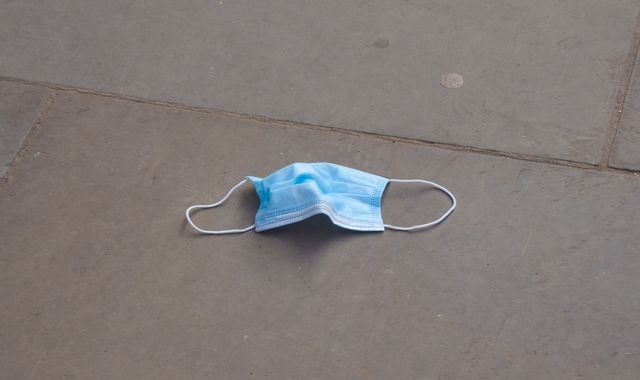COVID-19: Secondary pupils to wear face masks when schools reopen – here’s what to expect
Written by News on 25/02/2021
Children will return to the classroom in schools and colleges in England from 8 March – while secondary school pupils will have to wear face masks, it has been announced.

Here are some of the measures that will continue to be carried out to try to keep staff and pupils safe – and what to expect in other parts of the UK.
England
When schools and colleges reopen in England on 8 March, practical teaching will also resume at universities.
The rest will need to continue learning remotely with the options being reviewed by the end of the Easter holidays, the prime minister has told the Commons.
The wearing of face masks will also be made compulsory in secondary schools.
On 22 February, Mr Johnson said: “All the evidence shows that classrooms are the best places for our young people to be and that’s why I’ve always said that schools would be the last to close and the first to reopen.
“Two weeks from today, pupils and students in all schools and further education settings can safely return to face-to-face teaching supported by twice-weekly testing of secondary school and college pupils.
“Families and childcare bubbles will also be encouraged to get tested regularly.
“Breakfast and after-school clubs can also reopen and other children’s activities, including sport, can restart where necessary to help parents to work.
“Students on university courses requiring practical teaching, specialist facilities or on-site assessments will also return.
“But all others will need to continue learning online and we will review the options for when they can return by the end of the Easter holidays.”
The roadmap set out by the government recommends that the use of face coverings “is extended for a limited period to all indoor environments – including classrooms – unless 2m social distancing can be maintained”.
However, a coalition of education unions and professional bodies has warned a full return of all pupils at the same time would be a “reckless” course of action.
Primary and secondary schools have offered remote learning for most pupils since the beginning of January, although the children of critical workers and vulnerable children have been able to still attend.
GCSE, AS and A-level exams will not go ahead as planned in 2021, with Education Secretary Gavin Williamson announcing that teachers can use questions set by exam boards to help determine grades for students.
A-level students will get their results on 10 August, while GCSE pupils will get their grades on 12 August. These earlier dates will allow more time for students to appeal their grades, if they believe they are unfair.
Primary school SATs will not go ahead this year, nor will phonics or timetable testing.
And universities have been offering remote teaching.
How are schools and colleges going to reopen in England?
Schools will be asked to continue with a range of protective measures, like those which were adopted during the autumn term.
Each school and college throughout the country will implement measures in a different way and which is more suitable to their own surroundings.
The measures will continue to include good ventilation, the use of PPE, social distancing and regular hand washing.
What testing is expected to take place?
Rapid lateral flow tests will continue to be made available to schools and colleges because they are small, portable and provide quick results.
The tests produce a result in 30 minutes and do not require a laboratory to process.
However, there is still continuing concern that the speed of the tests comes at some cost in accuracy – with some believing the results are compromised if the testing is not done properly.
Lateral flow tests are carried out to try to identify individuals with COVID-19, but who are not showing any symptoms. This makes up a third of all cases.
A negative test result does not remove the risk of transmission. In some cases, someone who has tested negative may still have the undetected disease and be infectious.
It is not clear how many test kits will be made available to schools.
Many schools and colleges were forced to ration the use of such kits earlier in the pandemic because of a low supply.
Schools and parents will most likely still be expected to take responsibility for the testing of pupils and students.
How often will testing be carried out?
So far, the lateral flow devices provided to schools allowed for staff and teachers to access two rapid tests every week.
Mr Johnson said there will be twice-weekly testing of secondary school and college pupils.
What is being said about all schools returning on the same day in England?
Teachers’ unions have said bringing all pupils back on the same day – 8 March – is “reckless” and want a more “cautious” approach to avoid an increase in new infections.
Steve Chalke, head of the Oasis Academies Trust which runs more than 50 schools across England, told Sky News a “gradual return” would be more sensible.
“If you look at Scotland and you look at Wales, what they’ve adopted is a phased return or a staggered return and that’s for all sorts of reasons,” he said.
“We would say the wise way forward is a step-by-step gradual return where you can monitor how you’re doing and you can monitor whether you’re going too fast and slow down a bit.
“It seems to us that that’s the only sensible way forward because our freedom has got to be won. I think we need to be cautious and move ahead in that way.”
Analysis: As home schooling ends, the catch-up work begins
By Laura Bundock, news correspondent
We finally have the date and some detail about the reopening of classrooms. Within a fortnight, all pupils across England will be back at school.
For families struggling with home schooling, the end is in sight.
The return will involve twice-weekly tests for secondary pupils, and they’ll have to wear masks in classes, too.
Schools will start the testing, with kits then sent home. But there won’t be testing for younger primary pupils.
Closed classrooms have perhaps been one of the most dismal sights of the pandemic. The longer kids are at home, the greater the concern about their well-being.
And there are fears the second lockdown has further exposed the gap between the poorest pupils and their classmates.
But is a mass “big bang” return on 8 March risky? There are still those who feel a staggered return would have been safer.
Teaching unions are angry their calls for a phased approach were rejected.
It is impossible to say how much infection rates might be affected, but things will be closely monitored.
No one wants classes shut again.
And as home schooling ends, the catch-up work begins – identifying those who’ve struggled the most, and ensuring no child is left behind.
Scotland
Nicola Sturgeon has confirmed there will be a staggered return of schools starting with children in primary school years one to three going back from today.
Secondary school pupils, who need to complete practical work towards achieving a qualification, have also been allowed back from today, but must socially distance.
No other pupils will return before 15 March, the Scottish first minister has said.
On pupils returning to the classroom as part of a phased approach, Ms Sturgeon said she hopes more children will “go back to school next month”.
She added it would depend on continuing to “suppress the virus” and that vaccination would play a “bigger role” to allow all children to return.
Wales
Children aged three to seven (in the Foundation phase from nursery to year two) will return to school full-time after half-term – which for most state schools is today.
They have been prioritised due to being least likely to transmit coronavirus, while also having greater difficulties with remote learning.
There will also be returns for some vocational learners, including apprentices, to colleges in order to access training or workplace environments for their practical qualifications.
Welsh education minister Kirsty Williams said that “if conditions continue to improve” then all primary school pupils will be able to return from 15 March.
Secondary school pupils in years 11 and 13 will return on the same day, she added.
Where possible, there will be some flexibility to get pupils in years 12 and 10 back into school if they are entered for exams this summer.
“My preference is to get all learners back in school after the (Easter) break,” she said.
Ms Williams said the situation would be confirmed before the Easter holidays.
As with England, schools and colleges are currently open for children of key workers, vulnerable learners and those completing essential exams or assessments.
Special schools are open where possible.
The Welsh government has also cancelled GCSEs, AS and A-levels.
Grades will be determined by teachers, based on evidence such as mock exams and coursework.
Northern Ireland
The Stormont administration has said most pupils in Northern Ireland will not return to school until 8 March.
Vulnerable children and children of key workers can go to school and special schools can open.
(c) Sky News 2021: COVID-19: Secondary pupils to wear face masks when schools reopen – here’s what to expect







